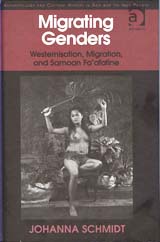-
Migrating Genders: Westernisation, Migration, and Samoan Fa'afafine is an important, in-depth and comprehensive examination of the lives of fa'afafine in New Zealand and Samoa. While I have some major issues with the book it has a central place in the ongoing debates around the changing face of Pacific sexualities.
-
In Migrating Genders, Johanna Schmidt examines how fa'afafine in both Samoa and New Zealand understand their gender and sexuality, and how these are situated within the Samoa's gender system and the west's globalising of gender and sexuality. It draws on interview data with fourteen fa'afafine and describes the diversity and the uniqueness of fa'afafine identities. It will be of most interest to those scholars of sexuality and gender but also to anthropologists and sociologists. Four of the book's eight chapters use the rich interview data collected. Schmidt first describes previous scholarship on fa'afafine, other transgender subjects as well as more theoretical work by authors such as Judith Butler. She then traverses the sex/gender divide in Samoa and the place of fa'afafine within that and the division of labour. In the next four chapters Schmidt plots the trajectories of fa'afafine lives as she describes life in Samoa, migration to New Zealand and in Chapters 6 and 7, the major issues of sexuality and gender facing this group. In her conclusion she returns to the tensions within fa'afafine in negotiating Samoan and New Zealand cultures and their agency in dealing the complexities of their everyday lives.
-
Schmidt argues that her intention is to avoid the exoticising ethnographic gaze by not focusing on sexuality and by allowing the voices of fa'afafine to be dominant in the text. But she fails in this claim. First, the book's cover is a black and white ironic 'ethnographic' photographic portrait of fa'afafine sexuality by Shigeyuki Kihara, which questions the colonial gaze but at the same time makes that gaze central to the content. What Schmidt does not admit is that the 'Western discursive lens' (p. 24) is inevitable and her book is part of it. Second, apart from a list of quotes to begin the introduction we do not hear from her fa'afafine subjects for the first third of the book. The first two chapters of the book are too long—a tedious dissertation-type repudiation of the scholarship of many of those (including Samoan authors) who have gone before her (always the problem of those who turn their PhD theses into a book).
-
It is when you get to the final three chapters that Schmidt's work becomes most important and easy to read. I like the positioning of a more traditional form of fa'afafine in Samoa around the gender division of labour, although this is also a sexual division of labour—here Scmidt situates Samoa-based fa'afafine in ways that other authors have not done to date. In Chapters 6 and 7 she moves onto territory covered by many other researchers on transgender identities—femininity and ambiguity, and she has some important insights to offer the field. Her work, like that of others, indicates that sexual difference is not necessarily experienced as trauma.
-
While Schmidt's view is that a rights-based community of fa'afafine in Samoa is antithetical to Samoanness, there is evidence of a groundswell of just such a movement driven by fa'afafine associations and the Pacific Sexual Diversity Network.
On a more empiricist note, it would have been good to see the book better grounded in knowledge of sexual health issues in Samoa. Schmidt argues, 'Mead's suggestion of high levels of sexual activity among unmarried Samoan youth do appear to be misplaced' (p. 62). Yet the 2005 second generation surveillance data indicated that of 300 Samoan youth surveyed, the average age at first sex for both males and females was 17 and that over a quarter were sexually active in the last year, with half of those having multiple sexual partners. Chlamydia rates among under 25-year-old women at ANC was a staggering 40.7 per cent. [1]
-
Despite the caveats, above, this book will be very helpful for those of us working in the area.
Endnote
[1] World Health Organisation, Second Generation Surveillance Surveys of HIV, other STIs and Risk Behaviours in Six Pacific Island Countries, Suva: WHO, 2006.
|



